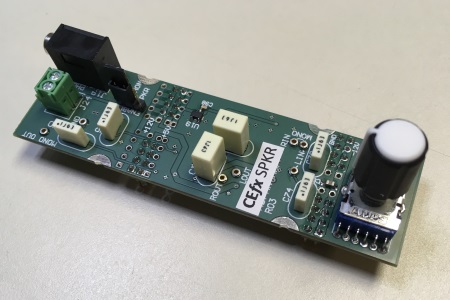

 Loading product data...
Loading product data...

This module has stereo (2-channel) inputs, stereo headphone outputs via a standard 3.5mm jack, and a single mono speaker output via screw terminals. It is capable of driving about 2W into a 4Ω speaker load. A high efficienty 4Ω full range speaker will produce sound enough to fill a room. It is designed to avoid common power-on/off pops and thumps.
For stereo signals, send the left signals into either of the LIN testpoints and the right signals into the RIN testpoint. Send mono signals into the leftmost LIN testpoint, then run a jumper wire from the rightmost LIN testpoint to the RIN testpoint above it.
Wear headphones responsibly. Slip them off your ears when powering on or off. When making changes to a setup, start with the volume turned down.
Although practically any speaker will work, best results come from using a high-efficiency full-range 4-Ohm driver. The module's maximum output power is about 2W into a 4-Ohm load.
Depending on its configuration, your module might come with a switch to select headphone or speaker mode, or a jumper. Operation is the same -- slide the switch or move the shunt to the HPHON setting to enable the headphone, or the SPKR setting to enable the speaker.
The signal path is stereo (2 channel) except for the speaker output which is mono. For mono sources, the user shorts TP91 and TP78.
To allow for wide variety of input signal levels, the signal path starts with a ganged (e.g. 2 channel) 20K volume control, then followed with non-inverting amplifiers. As shipped this module is configured for unity gain (R84 and R79 not installed), which is about right for synth- and guitar- level signals which typically range from 4V to 10V. Installing those resistors can increase the gain to boost weaker signals, like from consumer audio ("line level") sources (typically 1V).
The volume-adjusted buffered input signals are available on TP76 and TP74. They also go directly to a stereo headphone amplifier U16 (NCP2811) set up for unity gain (R76 = R81).
The headphone amplifier chip (NCP2811) is an excellent device. Unlike most single-voltage headphone amplifier chips, it avoids DC offsets and power-on pops by creating a negative power supply voltage. That seems a bit pointless in a circuit that already has -12V, but also has an enable/disable ability which performs the headphone/speaker switching function and it prevents power-on pops. Although the NCP2811 datasheet gives +5V as a maximum supply voltage, any overshoot of the 5V rail can cause damage to this device so we added U19 (regulator) to make a nice, quiet 3.3V supply for it.
For the mono speaker output, the stereo signals go to summing amp U20A, a standard design, and then into speaker driver U18. The SSM2305 is a well-behaved power amplifier that has the required shutdown mode. When used in a desktop/experimental situation with a speaker nearby, a couple of watts of power is sufficient. It can fill a classroom when driving an efficient 4-Ohm speaker. Although the SSM2305 works fine with a single-ended input, since there was a spare op-amp (U20B) it was used to invert the summed mono signal and create a differential input for the SSM2305. It probably doesn't improve anything, but it just makes us feel better.
The ~SD pins on both U16 and U18 are an active-low shutdown. TP59, TP67, and TP79 can be populated with a jumper block, or a small slide switch, or wires to a front panel.
It is not enough to rely on the built-in pop suppression, because the +/-12V power lines may take longer to stabilize than the +5V line. So on power up, the thump created by offset shifts in U15 (and previous op amps in the audio chain) can feed through the NCP2811 after it has unreset itself. The solution is to add zener diode D9 and R102 to create an enable signal that depends on the +12V line being mostly stable. This is enough to get rid of the thumps.

